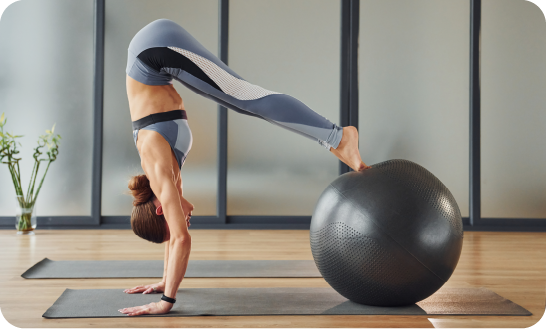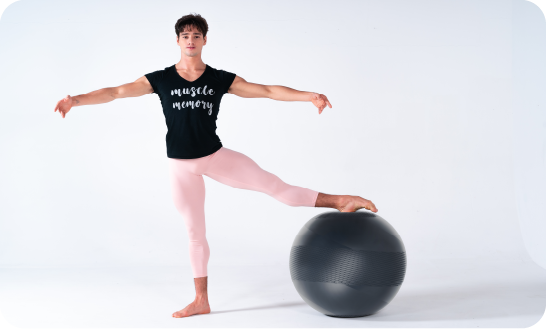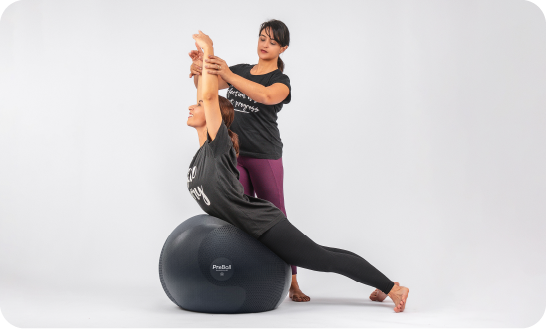The Science Behind Exercise Balls
Scientifically proven to enhance core strength, the exercise ball is a true tried and tested tool in an industry abundant with fads that overpromise and underdeliver.
Introduction
Historically used to promote spine health and improve balance, the exercise ball holds a certain prestige for dancers, athletes, yogis and pilates practitioners pursuing optimal physical performance.
Recognising the exercise ball as a game changer in dance and athletic performance, PBT has created the ProBall. With advanced grip technology and burst-resistance up to 1000kgs, the ProBall provides a comprehensive solution to effective technique training across all athletic fields.
What is an Exercise Ball?

The exercise ball, originally known as the ‘Pezzi ball’, was named after its Italian manufacturer Aquilino Cosano. Large and inflatable, the ball was originally designed to support spine health. Due to its proficiency in correcting muscle imbalances, It wasn’t long before the exercise ball gained huge acclaim across Europe. Indeed after traveling the world, the ball soon became affiliated with another country, Switzerland, and consequently adopted a new name: Swiss ball.
Also known as a stability ball or pilates ball, the exercise ball can be used effectively to improve and enhance balance, coordination, strength and mobility.
The Science Behind Core Strengthening
The core is the body’s powerhouse and plays a very important role in preventing back pain, poor posture and injuries. Though commonly reduced to the abdominal muscles, the core actually comprises the low back, hip extensors, transverse abdominals, obliques and pelvis. Exercise ball training facilitates a harmonious activation and engagement of these core muscles.
How do exercise balls improve core strength?
The exercise ball produces an instability that the body is then forced to respond to in order to stabilise and balance whilst using the ball. During exercises, local and global muscles work to facilitate controlled and stable movements. The more difficult the movement on the exercise ball, the greater the muscle activation, and the more the body learns to adjust and correct instabilities. The muscle memory developed during exercise ball training can then be harnessed during athletic performance.
Far from a ‘get abs quick’ scheme, core strengthening with an exercise ball helps dancers and other athletes mindfully build a secure foundation for proper alignment, better balance, higher jumps and faster turns. Beneficial for athletes, pilates practitioners, yogis and dancers, the exercise ball is a deserving celebrity of the fitness industry.
The Power of Proprioception

Other than ‘pirouettes’ and ‘pointed toes’, there exists another important ‘p’ in physical training: proprioception. This is defined as the body’s ability to co-ordinate itself in space and can be greatly enhanced through the use of an exercise ball.
Proprioception and balance
Stabilising on the exercise ball not only strengthens the core muscles but also requires the coordination of these muscles. The body’s proprioceptive system coordinates unconscious reflexes to stabilise whilst on the ball using information provided by muscle and joint sensations. The muscles that attach to the lumbar vertebrae are known as local muscles and have a greater proprioceptive function. As exercise balls tend to stress local muscles more, training with the ball enhances this proprioceptive function and thus improves balance.
Exercise Balls and Injury Prevention

A flexible and mobile spine is not just a desirable quality in dancers but a prerequisite for a long and healthy career in and out of the studio. The exercise ball was primarily designed to improve spine health and its value in performing this role has not depreciated.
Who should use an exercise ball?
A scientific study recorded in the Journal of Strength and Conditioning Research showed conclusive evidence in support of exercise ball training. The study deduced that exercise balls ‘can improve strength, endurance, flexibility and balance.’ As this research was conducted using sedentary women, it is clear that the benefits gained through exercise ball training are not exclusive to athletic training.
How can exercise balls enhance performance?
With dance and athletics becoming increasingly demanding for sportsmen and bun-heads alike, the need for supplementary training has never been more paramount.
Low-impact training using the exercise ball enables dancers and athletes to safely strengthen by reducing the pressure on their joints. In addition to supporting rehabilitation, the exercise ball can also be used preventatively to limit the potential of future injuries. By encouraging a neutral position of the spine and supporting correct posture and alignment, the exercise ball facilitates healthy and effective strength and mobility training.
Choosing the Right Exercise Ball?
The globe-like body of the exercise ball provides a world of opportunities when it comes to core strengthening and injury prevention. However, understanding how to use the ball and choosing a high-quality ball is crucial to optimising its benefits.
The most common complaints heard when discussing exercise balls pertain to discomfort, a slippery surface and low durability.
Heeding these concerns, PBT has sought to address them with the creation of a lightweight, durable and burst-resistance premium exercise ball. Crafted with a unique texture grip, the ProBall provides a stable, non-slip surface to support you through the sweatiest of sessions. This exercise ball is also the first of its kind to use gym ball PVC, ensuring burst-resistance up to 1000 kgs. For dancers traveling to auditions, competitions or tours, the lightweight and compact design of the exercise ball makes it perfect for on-the-go training.
Expert Exercise Ball Training with PBT

Progressing Ballet Technique training uses the exercise ball to enhance core strengthening, improve balance and better co-ordination. During PBT classes, dancers, pilates practitioners yogis and athletes are expertly led through exercises specifically designed to optimise the benefits provided by the exercise ball. With a mission to support dancers through every step of their training, PBTs comprehensive training method provides dancers with a safe and effective means of enhancing their technique.
Via PBT's online platform, dancers can gain access to a library of expertly crafted exercises designed to improve posture, develop correct alignment and enhance their performance.
FAQ:
What size exercise ball is right for me?
- The PBT exercise ball comes in 3 sizes: small, medium and large. When choosing the size, you will need to consider your height and leg length. PBT's size guide gives detailed instructions on choosing the right size exercise ball.
I am not an athlete; can I still use an exercise ball?
- Yes! Exercise balls are very versatile and can be used to enhance physical therapy, mobility training and strength training. PBT exercises incorporate all three uses.
Are exercise balls eco-friendly?
- Most exercise balls are made from non-recyclable rubber or plastic. However, PBT’s Pro-Ball is made using eco-friendly PVC, showing our commitment to environmental sustainability.
Sign up to our newsletter
Receive tips, news, and advice.